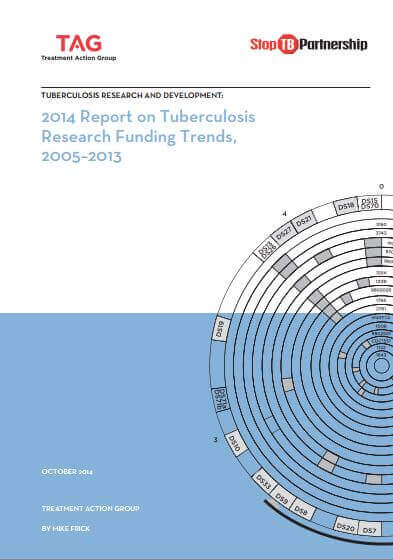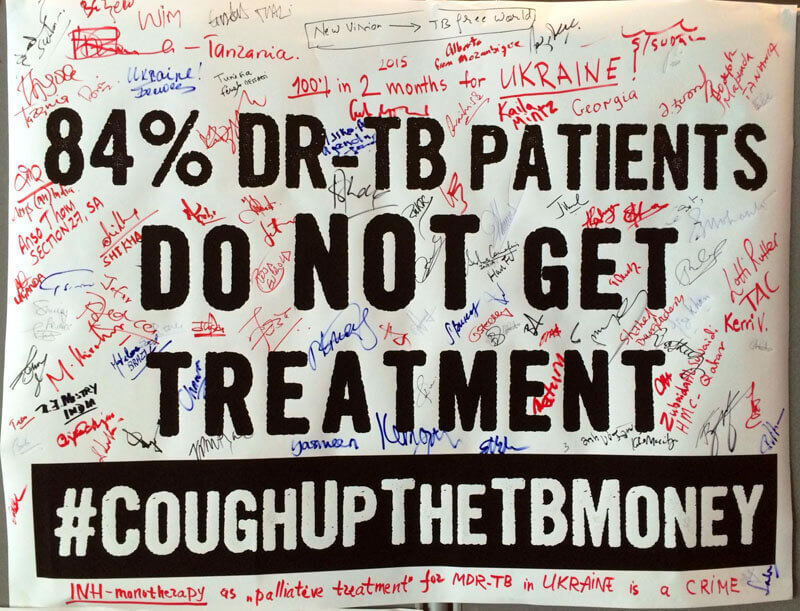 At the 45th Union World Lung Health Conference, TB activists called for more funding for TB R&D. Photo: Steve Forrest/The UnionIn this guest post, Mike Watson Frick—TB/HIV program officer at Treatment Action Group (TAG)—writes about the state of tuberculosis (TB) research funding and civil society actions that took place at the recent Union World Conference on Lung Health in Barcelona, Spain.
At the 45th Union World Lung Health Conference, TB activists called for more funding for TB R&D. Photo: Steve Forrest/The UnionIn this guest post, Mike Watson Frick—TB/HIV program officer at Treatment Action Group (TAG)—writes about the state of tuberculosis (TB) research funding and civil society actions that took place at the recent Union World Conference on Lung Health in Barcelona, Spain.
At the end of last month, the global community of TB scientists, activists, and healthcare workers gathered in Barcelona, Spain for the 45th Union World
Conference on Lung Health. For the first time, the conference opened with a rousing call by civil society organizations to triple annual spending on
TB research to US$2 billion per year. At the conference's opening ceremony, activists from Treatment Action Campaign (TAC), TAG, the Global TB Community
Advisory Board, AIDS Free World, International Treatment Preparedness Coalition, and HIV i-Base called on governments, donors, and industry to #CoughUpTheTBMoney to fully fund TB research and the development of new TB treatments.
The activists who took the stage in Barcelona were reacting to the dismal news contained in a report released by TAG the previous week showing that funding
for TB research in 2013 fell $1.3 billion short of the $2 billion the Stop TB Partnership estimates the world must spend each year in order to eliminate
TB as a public health threat.
 2014 Report on Tuberculosis Research Funding Trends. Photo: Treatment Action GroupTAG's annual Report on Tuberculosis Research Funding Trends shows that funding for
TB research has flat lined since 2009. After declining in 2012, funding for TB research & development (R&D) increased slightly in 2013, due
largely to an increase in spending by the Bill & Melinda Gates Foundation. Worldwide, governments, charities, industry groups, and multilateral
organizations spent just $676.6 million on TB R&D in 2013. Funding shortfalls persist in every category of TB research tracked by TAG—basic
science, diagnostics, drugs, vaccines, and operational research—making 2013 the ninth straight year of missed funding targets. The gap is largest,
in absolute terms, in TB drug research where funders spent just $255 million of the $740 million funding target.
2014 Report on Tuberculosis Research Funding Trends. Photo: Treatment Action GroupTAG's annual Report on Tuberculosis Research Funding Trends shows that funding for
TB research has flat lined since 2009. After declining in 2012, funding for TB research & development (R&D) increased slightly in 2013, due
largely to an increase in spending by the Bill & Melinda Gates Foundation. Worldwide, governments, charities, industry groups, and multilateral
organizations spent just $676.6 million on TB R&D in 2013. Funding shortfalls persist in every category of TB research tracked by TAG—basic
science, diagnostics, drugs, vaccines, and operational research—making 2013 the ninth straight year of missed funding targets. The gap is largest,
in absolute terms, in TB drug research where funders spent just $255 million of the $740 million funding target.
The human consequences of such anemic funding for TB drug research were voiced by many of the TB patients and survivors attending the conference in Barcelona.
At the opening ceremony, two women personally affected by TB read statements about their experiences, illustrating the pressing need to support research.
Portia Serote of TAC described the lengthy duration, side effects, and difficulties of receiving drug-sensitive TB treatment, while Stephanie A.—a
woman from Los Angeles whose brother has extensively drug-resistant (XDR)TB—described how side effects from XDR TB drugs are causing her brother
to lose his hearing, as well as feeling in his hands and feet. For both drug-sensitive and drug-resistant TB, shorter, less-toxic regimens would improve
the arduous journey patients must endure to cure their TB.
Yet desperately needed progress in TB research rests on a shaky financial foundation rocked by two forces. First, the pharmaceutical industry is abandoning
TB research as reflected in the 33 percent drop in industry spending from $144.97 million in 2011 to $99.6 million in 2013. With expenditures under
$100 million, the private sector now spends less on TB R&D than it did in 2009 at the peak of the economic crisis. Even more alarming, 60 percent
of industry spending on TB research in 2013 came from one just one company: Otsuka. Not considering Otsuka's investment of $58.7 million, other private
sector companies mustered just $40 million on research to develop new TB drugs, diagnostics, and vaccines. Three pharmaceutical companies have left
TB research in as many years, a rate of attrition driven by an industry-wide shift away from anti-infectives research as pharmaceutical companies either
concentrate on more lucrative endeavors—such as developing new vaccines and drugs for chronic diseases or pursuing mergers and acquisitions to
focus on core business. The abandonment of anti-infectives work has become severe enough to prompt a Presidential executive order that includes a recommendation to give incentives of $800 million per year for pharmaceutical companies to develop new drugs.
 Conference participants signed posters with the rallying cry #CoughUptheTBMoney. Photo: Mike Frick/TAGPharmaceutical disinvestment is increasing pressure on public funders to shoulder a greater percentage of TB R&D funding at a time when many government
agencies are fighting off the shortsighted cutbacks of fiscal austerity measures—the second force undermining TB research. Federally mandated,
across-the-board budget cuts under sequestration in 2013 led to lower TB R&D spending at the US National Institute of Allergy and Infectious Diseases
and the US Centers for Disease Control and Prevention—the first and ninth largest funders respectively of TB R&D globally. Sixty-two percent
of public money for TB research comes from one country—the United States—revealing the TB research endeavor’s depth of dependency on just
a handful of public agencies, whose budgets are either being actively scaled back or, at best, failing to keep pace with inflation and the rising costs
of biomedical research.
Conference participants signed posters with the rallying cry #CoughUptheTBMoney. Photo: Mike Frick/TAGPharmaceutical disinvestment is increasing pressure on public funders to shoulder a greater percentage of TB R&D funding at a time when many government
agencies are fighting off the shortsighted cutbacks of fiscal austerity measures—the second force undermining TB research. Federally mandated,
across-the-board budget cuts under sequestration in 2013 led to lower TB R&D spending at the US National Institute of Allergy and Infectious Diseases
and the US Centers for Disease Control and Prevention—the first and ninth largest funders respectively of TB R&D globally. Sixty-two percent
of public money for TB research comes from one country—the United States—revealing the TB research endeavor’s depth of dependency on just
a handful of public agencies, whose budgets are either being actively scaled back or, at best, failing to keep pace with inflation and the rising costs
of biomedical research.
Reducing TB deaths by 95 percent and cutting the number of new TB cases by 90 percent by 2035—the two goals of the post-2015 TB strategy approved by the World Health Assembly (WHA) in May 2013—will require research to develop and introduce new tools. The WHA notes that new tools
must be introduced no later than 2025—and preferably sooner. Yet chronic underfunding of TB research jeopardizes this vision of achieving a world
free of TB. Reversing this stagnation will require building a movement for TB research that can bring money, muscle, and political commitment to bear
on research funders—new and old—from all sectors. The message to #CoughUpTheTBMoney, repeated throughout the meeting in Barcelona and endorsed
by hundreds of signatures from conference delegates, represents a small but significant first step toward building a stronger TB research movement.



